How to Store Bread Pudding? Do You Refrigerate It?
Baked your first bread pudding and not sure if you should refrigerate it or not? How to store bread pudding?
After your bread pudding cools to room temperature, transfer it into an airtight container or a cake carrier, and put it in the fridge. If you don’t have a big enough container, cut the pudding into smaller pieces and place in containers or wrap the whole thing in plastic wrap.
That’s the 2-sentence answer in case you’re in a hurry.
Interested in details? Here’s what we cover below:
- storage practices for bread pudding, including what to do with the sauce or topping
- how long bread pudding lasts
- ways to reheat bread pudding leftovers
Read on.
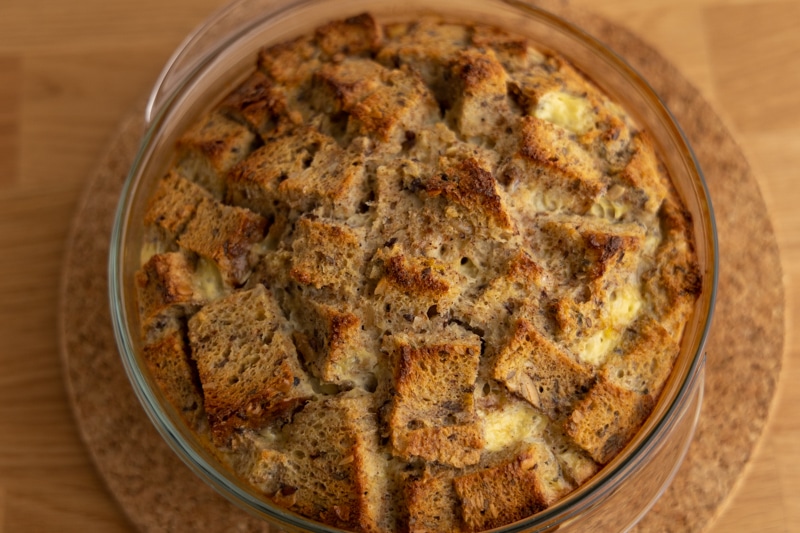
How to Store Bread Pudding
After cooling your bread pudding to room temperature, place it in an airtight container or wrap using plastic wrap, and refrigerate. Covering the dessert ensures it doesn’t pick up any smells and doesn’t dry out, plus it prevents cross-contamination.
Refrigeration is necessary because bread pudding is a super moist baked good, which means it can quickly grow mold if it sits on the counter.
Of course, bread pudding tastes best warm, so reheating it before serving is always a good idea (more on that later). Simply taking it out of the fridge 30 minutes before consumption won’t do the trick.
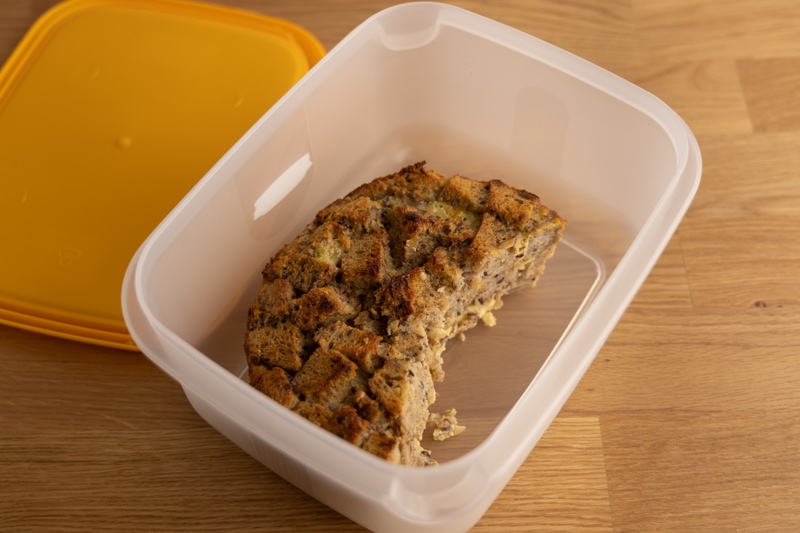
Should You Store Bread Pudding Topped or Not?
The answer to that question depends entirely on what sauce or topping you’re adding to your bread pudding.
If it’s ice cream, you add it right before serving the dessert. That’s a no-brainer. If you leave it in the fridge, it will melt completely.
If the topping doesn’t last particularly long without losing quality, you should prep it fresh and add before serving too.
A good example here is homemade whipped cream. If you don’t stabilize it, homemade whipped cream keeps quality for only a day or so. That means topping your bread pudding with it effectively shortens the dessert’s storage time to only 16 to 24 hours.
Last, if it’s a custard sauce or any other that keeps well in the fridge, you can add it onto your bread pudding before storage, store it separately in a sealed container, or whip a fresh portion before serving. That’s your call.
Does Bread Pudding Need to Be Refrigerated?
You should refrigerate bread pudding after it cools to room temperature. That’s because it’s a dessert loaded with eggs and milk, and therefore a very moist one.
As you probably know, moisture combined with room temperature storage is a sure recipe for mold growth. That’s what we’re trying to avoid, and which is why you store bread pudding in the fridge.
I’ve read in a few places that you can store it on the counter for a couple of days, but I wouldn’t risk it. It might as well be moldy the very next day.
Besides, most reputable recipe sites and bloggers also suggest refrigerating the leftovers (here are Preppy Kitchen, Fantabulosity, and Life, Love and Sugar talking about bread pudding).
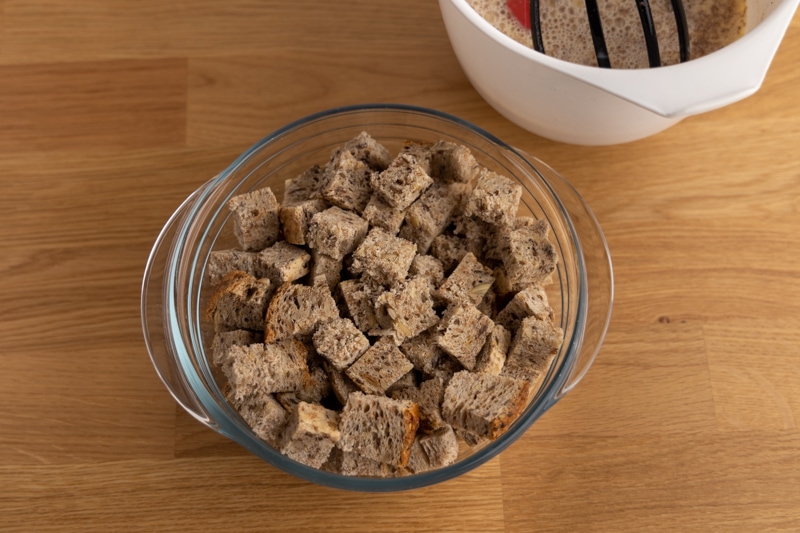
How Long Does Bread Pudding Last?
Bread pudding keeps for 4 to 5 days sealed in an airtight container and in the fridge. If using containers isn’t an option, you can wrap the whole thing tightly with plastic wrap and refrigerate.
If those 4 to 5 days aren’t enough, you can freeze the leftovers.
The good news is you can make bread pudding ahead of time. If you reheat it and add a fresh topping right before serving, hardly anyone will tell the difference.
Like most cakes, pies, and desserts, there isn’t anything else you can do to prolong the storage time besides freezing the leftovers. Let’s discuss that option.
Can You Freeze Bread Pudding?
Main article: Can you freeze bread pudding?
You can freeze bread pudding, and it freezes quite well.
The whole procedure is super simple: you portion the dessert, wrap it tightly in plastic wrap or aluminum foil, and freeze it in a freezer bag. Since bread pudding is quite moist, a good wrap is important because it prevents or at least reduces freezer burn.
Once frozen, bread should retain quality for at least a month or two.
When you’re ready to enjoy it, defrost it and reheat before serving for optimal experience.
I strongly suggest thawing bread pudding in the fridge, the same way you go about defrosting any other food that requires refrigeration. Depending on the amount, the process takes between 4 to even 12 hours.
To make things even simpler, I recommend thawing bread pudding overnight.
Once it’s cold but no longer frozen, it’s time to reheat the bread-based dessert. Let’s talk about how.
How to Reheat Bread Pudding?
There are a couple of ways to reheat cold bread pudding. The most popular ones include:
- In the oven. Preheat your oven to about 350°F (~180°C) and warm up the dessert for 10 to 15 minutes. Cover it with aluminum foil so that it doesn’t dry out too much. If you’d like to get a crispy top, remove the foil for the last 1 to 2 minutes of heating.
- In the microwave. Place the bread pudding on a microwave-safe plate, and start by microwaving it for 30 seconds. Then switch to shorter 15-second bursts and continue nuking it until it’s warmed throughout.
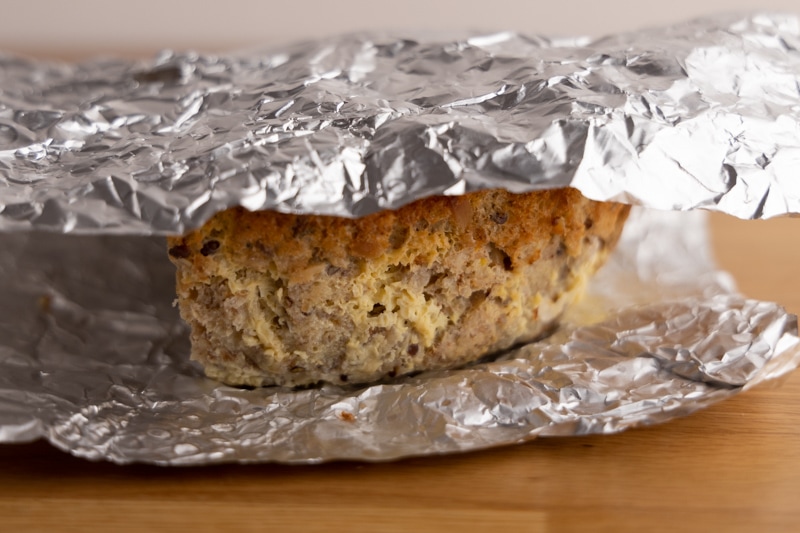
The oven works best if you’re reheating a large portion, while the microwave works great for quickly warming up small slices.
If you need to warm up a large portion in the microwave, cut it up into smaller ones and spread on a plate, or double the interval length but reduce the power to 50%. Either will help reheat your dessert more evenly.
Of course, other popular reheating methods can work just as well.
For instance, if you’re an air fryer user, you can use it to warm up cold leftovers in a similar way to the oven. The differences here are that you should use a slightly lower temperature and half the reheating time.
Rotten Records: Share Your Snap!
Caught some food past its prime? Upload your photo to “Rotten Records” and help others spot the signs of spoilage. Every image makes our food community safer and more informed!
![Does Hot Chocolate Expire? [Shelf Life, Storage, and Expiration]](https://www.doesitgobad.com/wp-content/uploads/Two-cups-of-hot-chocolate-768x512.jpg)
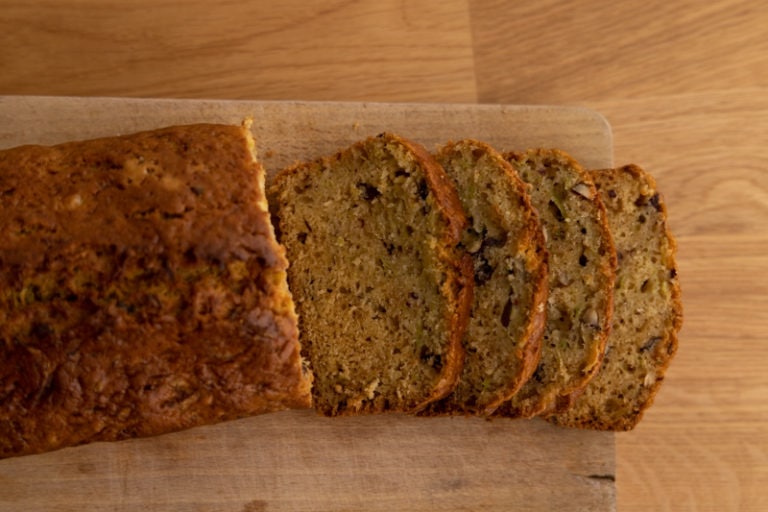
![Does Brown Sugar Go Bad? [Shelf Life, Expiration, Hardening]](https://www.doesitgobad.com/wp-content/uploads/Brown-sugar-closeup-768x512.jpg)

![Does Cream of Tartar Go Bad? [And How to Test if It’s Still Good]](https://www.doesitgobad.com/wp-content/uploads/Top_view_of_powdered_sugar_in_a_sieve.jpg)
![Does Flour Go Bad? [Shelf Life, Storage, and Expiration]](https://www.doesitgobad.com/wp-content/uploads/Adding-flour-when-prepping-cupcakes-768x512.jpg)